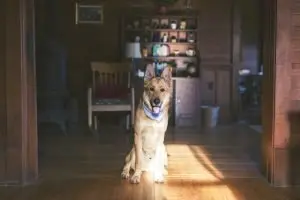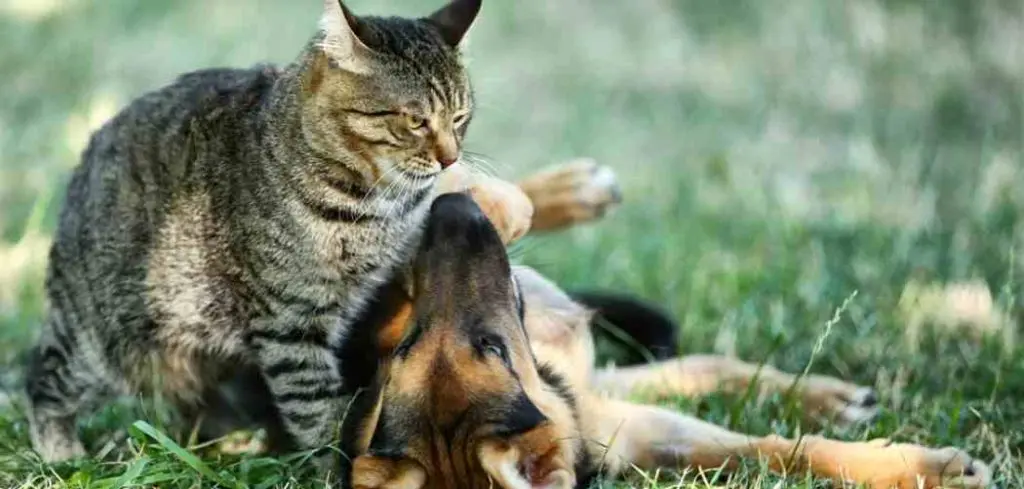
In our home Kovu the cat is top dog. He will determine when rough and tumble play is acceptable and when it’s time to curl up next to each other for a nap. In fact, Kovu the cat and our dogs are more ally than enemy.
Often going on missions together usually with the main end goal being food. Kovu has been known to jump up on the sides and pat food down to our dogs on many occasions.
An unfamiliar cat in the yard? No problems Kovu is up front scaring it off with complete back up and support from his three canine siblings … understandably he’s known locally as ‘thug cat’.
On the other hand, we have a very timid cat named Storm. Although our dogs are great with him now it wasn’t always an easy journey. Whenever storm got scared of something, maybe a leaf falling from a tree? he would run. As a puppy when Storm ran BooBoo our black German Shepherd would chase him.
This is because German Shepherds have a strong natural herding instinct and prey drive. Although when he was a puppy this was likely a game, we needed to ensure this behaviour stopped to ensure safe interaction as he got bigger and stronger.
Table of Contents
How well socialized is your German Shepherd?
A lot of how well your German Shepherd will get along with a cat will depend upon both its age and how well socialized it is.
The more positive exposure your German Shepherd has had to other animals the more likely they will be to get along with a cat. If your German Shepherd has had little exposure, they may need a bit more support from you on how to approach.
If your German Shepherd has had any negative exposure to other animals, it could cause them to become nervous which can make them aggressive. If your German Shepherd has had a negative experience with other animals, we would recommend seeking guidance from a dog trainer or your veterinarian on how to proceed.


Characteristics of a German Shepherd


Characteristics of a cat
During new situations and in new environments cats are generally more cautious and reserved than a German Shepherd. They will often prefer to sit back and watch for a while before deciding whether or not to get involved.
This assessment period will vary between different cats. For us Kovu will only access for a few moments before he boldly investigates whereas storm feels much safer watching anything new from a distance for as long as possible. Rarely will he make a move to investigate without the encouragement of a treat.
It’s good to keep in mind what characteristics you cat has when introducing your German Shepherd
Age of your German Shepherd
Generally, it is easier to bring a young German Shepherd puppy into your home with a cat than an older German Shepherd dog. This is because for the first three months of your German Shepherds life your puppy has less fear and more acceptance of new situations and experiences, this is called the crucial puppy socialization period (source American Kennel Club). For very similarly reasons a Kitten is easier to introduce to a German Shepherd puppy than an older cat.
However, if introduced properly there is no reason why an older GSD would not accept a cat being in its life.
How to introduce a German Shepherd to a cat
It is important for the physical and emotional safety of both your German Shepherd and your cat that take the introduction slowly. In calculated and measured way. Even if you think your German Shepherd and cat will get along well. All dogs are different therefore there is no time scale to follow on any of the steps listed below. You must use your best judgement to know when to move onto the next stage.
Safe place


Basic training
It is important before the physical barrier is lifted (or opened) that your German Shepherd understands some basic commands. Including “stay,” ‘sit” and the most important one “leave’ These commands will enable you to have just enough control to help keep both animals safe.
German Shepherds are very intelligent and by using positive training methods and treat rewards they should start to understand these commands quickly. You can also look into local kindergarten classes to help enhance your Germans Shepherd basic obedience.
When out on a leash if your German Shepherd tries to chase any living thing you must discourage them by telling them ‘No’. To reinforce the ‘No” make sure you stop walking or any fun play you may be doing with them. It is your GSD natural instinct to chase and herd. These instincts can be satisfied by throwing a toy for them to fetch and return. Depending upon the dog this can take a few attempts to master as it goes against everything their natural instincts is telling them to do. Like our Booboo who didn’t quiet master this one for a few months.
The first introduction
The initial meeting should be kept short and last between 5-10 minutes- these meetings can then gradually lengthen as your German Shepherd shows less or no signs of aggression towards your cat.
For your cat’s safety place whichever animal is the newest addition to the family into a large comfy crate. If at any time during the introduction your German Shepherd growls or shows any signs of aggression correct them with a stern “No” If this doesn’t snap them out of it immediately remove whichever animal isn’t in the crate from the room. If you’ve removed your German Shepherd place him in a room on his own for about 5 minutes and if it is safe to do so close the door. Removing your German Shepherd from the situation and placing them on their own for a time out enforces the “No” because, ‘you’ a good thing which has been removed.
If your German Shepherd reacts well and there is no growling or signs of aggression be sure to reward calm interactions with plenty of praise and treats. For more information on healthy treats please see our guide on healthy treats for a German Shepherd.
Introduction without the crate
When your better judgement tells you both animals are ready for the next stage you can go ahead and introduce your German Shepherd to the cat without the crate. To keep control of your German Shepherd you should keep them on a leash for this step.
To allow the face-to-face interaction for the initial meeting command your GSD to sit and stay. Letting them gradually approach your cat. If they stay calm give them plenty of praise and treats. However, if they aren’t calm and try to lunge at your cat tell your German Shepherd to ‘leave’. If they respond positively, try again. If they do not respond positively take them out the room for a time out before trying again.
Unleashed face to face
Only after consistent positive interactions and when your confident that your German Shepherd will remain calm and not pose a threat to your cat should you move onto this phase.
It’s also important to check on how your cat is feeling. It’s harder to gauge how receptive your cat is being to their new fur sibling however, signs your cat is feeling relaxed and calm are forward facing ears and pupils which are not either too large or too small.
If you have any doubt about your cat being ready for this stage, do not let your dog off its lead. Keep repeating the stages above until you are confident both animals are ready for this introduction.
Safe place revisited
Even now your German Shepherd and cat are acquainted its still important for your cat to have its own safe place which your GSD cannot access.
To do this you can either install a cat flap in the door of the cat’s safe room or you can use a child or pet gate to block the room off from your German Shepherd.
Other important information
- Never punish either animal. It’s important to keep introductions positive for long term effectiveness. It is not uncommon for German Shepherds to lunge or growl when first introduced. This does not mean your dog is aggressive it just their natural instinct.
- Introductions do not always go well first times. It important to stay positive and be patient. Your pets pick up on your emotions and you want to keep these interactions positive.
- No two animals are the same they all have own unique personalities and this can affect the time it takes for them to accept each other. Like our cat Kovu some are excited and eager to investigate their new companions whereas Storm and Zimba (our inbetweener) are more fearful and cautious which would make the process take longer. In the same respect BooBoo our Black German Shepherd was a very bouncy hyper puppy which scared our cats initially. Whereas our German Shepherd cross Malamute Yogi was very chilled and respectful.
- It is important to keep your guard up. Even if you’ve taken all the correct steps to introduced them and your German Shepherd and cat are well-socialized, problems can still occur.

